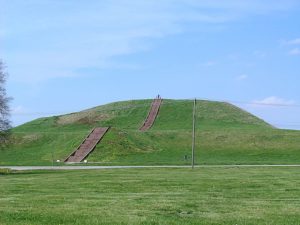
Cahokia in North America
 26. 01. 2018
26. 01. 2018

The historic area of Cahokia Mounds State is located on the site of an old Indian city, which existed here from about 600 AD to 1400 AD (although there are indications that the area was inhabited as early as 1200 BC). The city is directly across the Mississippi River near modern St. Louis, Missouri.
This historic park is located in the southern Illinois area between the eastern part of St. Louis and Collinsville. The park covers an area of approximately 9,8 km2 and contains 120 clay hills of various sizes, shapes and functions. All of these were created by man.
Cahokia
Cahokia is one of the largest and most influential urban cultural events in the Mississippi region, where an advanced civilization apparently developed across the southern part of the present-day United States more than 500 years before its first contact with contemporary Europeans.
It is believed that around 1200 AD, the population of Cahokia peaked and was even larger at that time than any European city at the time. It is quite possible that it will not be surpassed by any other city in the USA for another 1800 years.

Monk's Cluster of Pre-Columbian - Concrete staircase is modern, but is built along the approximate course of the original wooden stairs (© Skubasteve834)
Today, the Cahokia Mountains are home to the largest and most complex archaeological site north of Mexico City's pre-Columbian cities.
On wikipedia you will read:
Cahokia is an archaeological site near St. Augustine. Louis in the southern part of the US state of Illinois. On an area of less than nine square kilometers, there are around eighty canyons built by pre-Columbian Mississippi culture: the largest of these is the Monks Mound, a high 30 meter with a base area of over five hectares. The site was populated in 7. century and the greatest flourishing in 1050-1350, when it was the largest indigenous city in North America with about thirty thousand inhabitants. As a possible reason for the cessation of this civilization, climate change, the depletion of natural resources, or the invasion of enemies.
The houses on the top of the terraces were probably inhabited by a chieftain and priestly layer, and there were agricultural farms in the vicinity, dedicated mainly to the cultivation of corn. The inhabitants have not left written sights and their real name is not known (the name "Cahokia", which means "wild goose", is used since the 18 century and comes from Illiniwek language). Remains of human sacrifices and ritual funerals witnessing the bird cult, pottery and copper objects or stones used to play chunkey were also found, as well as the so-called "Cahokia Woodhenge" and regarded as an astronomical observatory. The area is protected as the National Historic Landmark and World Heritage.
UNESCO monument
The Cahokia Mountains are currently a national cultural monument and are protected by the state. In addition, it is one of the 21 UNESCO World Heritage Sites in the United States. It is the largest prehistoric clay structure of its kind in America in northern Mexico.
The entire area is open to the public and is managed through the Illinois Historic Preservation Agency and is supported by the Cahokia Mountain Museum.
In the picture you can see the comparison with Ganang Padang in Indonesia. An analogy would be found here.





 1
1